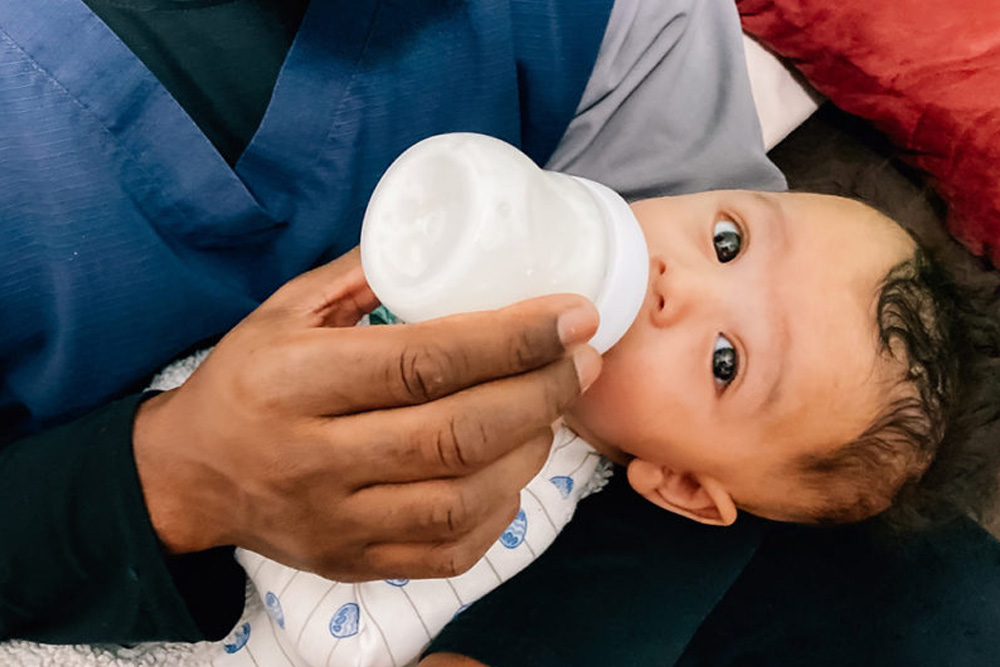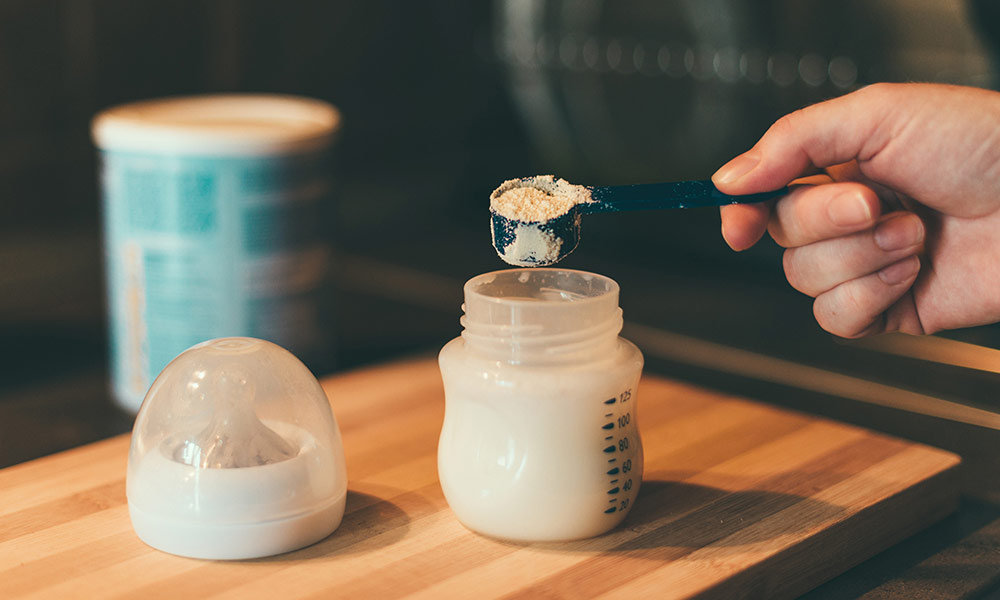A Beginner’s Guide to Formula Feeding

In the early days of parenthood, conflicting information, a lack of discussion on infant feeding options, and misconceptions about formula can make mixing a bottle seem like an intimidating test. But with a little knowledge, you can pass the mealtime exam with flying colors. Consider this your Intro to Formula class, and start taking notes on how to feed your baby safely and confidently.
Preparation and Storage
Baby formula comes in three different forms: powdered, which you mix with water; ready-to-feed (RTF), which can be served as-is; and concentrated, which must be diluted like condensed soup.
Powdered formulas are the most popular and economical choice, but they should be prepared carefully. The two big concerns with powdered formula are (1) using the wrong ratio of water to formula and (2) bacterial contamination. Both of these issues can cause serious health problems for your bottle-fed baby, but the risks can be easily avoided by making a habit of the following practices:
First, clean your hands, prep surface and the top of the can. (Antibacterial wipes work great for this.)
Measure the filtered water into the bottle first. If you put the powder in first, it will look like you’re adding the right amount of water baby needs when you’re really not. It’s all about volume and displacement. (See? Chemistry.)
Follow the manufacturer’s directions precisely because specifics for infant formula can differ from one brand to another. Check if the scoop is supposed to be leveled, and always use the scoop that comes with the can.
Never dilute formula with extra water. It can cause an electrolyte imbalance and impact first year growth and development.
Baby bottles can be left out for two hours at room temperature, but once your baby drinks any amount, the formula is only good for one hour. (This is because bacteria that might be present in your baby’s mouth could be introduced into the bottle and quickly colonize.)
You can also make formula in advance and refrigerate it for up to 24 hours. Opened RTF or concentrated formula can be kept for 48 hours in the fridge.
When a bottle has been finished or is past its prime, you’ll want to empty it and clean all of its parts with warm soapy water. You should always sterilize bottles before their first use and again every few weeks thereafter.
The First Feeds
A newborn’s stomach is about the size of a cherry, so most babies will need an ounce or less per feeding, every few hours, in the early days. But Stephanie Rodriguez-Moser, IBCLC, a lactation consultant in Minnesota, suggests watching your infant’s hunger cues (rooting, smacking lips, sucking on fingers and fussing are all baby cues) rather than the clock or the ounce markers on the bottle. Aim to start feeding before those cute fussing sounds turn into full-scale crying. An upset, overly hungry baby may have a hard time relaxing enough to eat well.
You might consider using RTF single-serving “nurser” bottles in the newborn stage for both safety and convenience. The 2- to 4-ounce bottles, available from several formula brands, only require you to attach a presterilized bottle nipple. Because no mixing is necessary, they’re immune to human error (which with all the upheaval the newborn stage brings, is only, well, human).
The cost of RTF formula can add up quickly, though, and provided your baby is full-term and healthy, safely prepared powdered formula is an excellent alternative. Or, you can use RTF for those first crazy weeks, and then switch to powdered once you’ve got the parenting thing down.

Establish the Right Position and Pace
Feed your baby upright at a semi-reclined position, holding her close in the crook of your arm, with the bottle tilted slightly toward her and at breast level. One way to make formula-feeding feel more intuitive is “paced bottle-feeding,” which emulates how babies nurse on the breast.
“Let baby take about 20 swallows, then tilt the bottle [back], leaving it in her mouth, until she begins to suckle again,” advises Rodriguez-Moser. “This gives your baby time to reorganize and breathe while feeding.” It also prevents overfeeding because instead of going until the bottle is empty, you’re reading your little one’s cues.
Also, skin-to-skin contact isn’t just for nursing moms. Bottle-feeding moms and dads can reap the benefits, too. So, strip baby down to the diaper, take off your shirt, and soak in the closeness.
Go With the Flow (Nipple)
Most bottle brands offer several types of nipples with varying speeds; younger babies usually need a slow-flow nipple or newborn nipple. “With the right flow, the baby will look relaxed, maintain eye contact with the feeder, swallow after every one or two sucks and complete a feed in about 10 to 20 minutes,” says Amy Welty-Peterson, IBCLC, who has extensively researched bottle-feeding techniques. “If the flow is too fast, baby may sputter, chug, look worried with a furrowed brow or break eye contact. If the flow is too slow, baby may suck three or more times between swallows, fall asleep before eating enough or cry.”
Consider Combination Feeding
Formula-feeding doesn’t have to be all or nothing. If you’re supplementing with the goal of exclusively breastfeeding down the line, focus on nursing as much as possible and using formula as a “top-up.”
If your intention is to do a combination of breast milk and formula from day one, “Breastfeed and pump for the first two weeks to take advantage of the milk-making hormones and establish long-term supply,” says Jody Segrave-Daly, RN, IBCLC, leader of the Fed is Best Foundation, who recommends offering a bottle of expressed milk at least once a day to avoid bottle refusal.
After this, “pick the time of day when you’re feeling less full, and skip nursing or pumping, so your breasts begin down-regulating your supply,” suggests Segrave-Daly. (Try self-expressing or pumping for a few minutes if you need to relieve discomfort.) “Continue this process every two or three days until you reach your infant feeding goals,” she says. Many moms find nursing every six hours and offering formula in between works well.
The Winning Formula
Everyone and their mother (and MIL) has an opinion on the right way to feed a baby. Block out the background noise, and stick to trusted resources. Find a pediatrician who is available when you have concerns and who will provide the support you need. From when to burp baby to reflux worries to weaning, there’s no shortage of questions that will pop up. You can also turn to trustworthy online communities for peer support and camaraderie to get you through the early days.
Once you’ve found the right formula and gotten the hang of safely preparing it, you get to relax and enjoy the fun part: watching your baby grow and thrive with the knowledge that you’re doing all you can to keep her happy, healthy and fed.
Suzanne Barston is the author of Bottled Up: How the Way We Feed Babies Has Come to Define Motherhood, and Why It Shouldn’t and the founder of FearlessFormulaFeeder.com.







